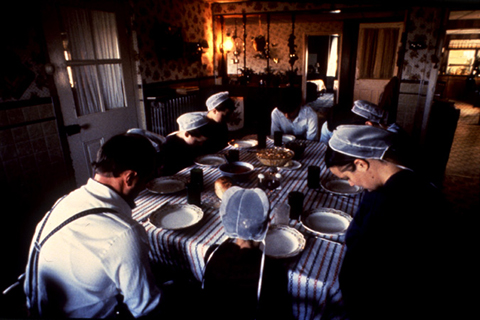Rare genetic mutation in Amish population linked to ‘bad’ cholesterol levels
Low-density lipoprotein, or LDL, is commonly called “bad” cholesterol since high levels of LDL contribute to a higher risk of coronary heart disease.
A recent study conducted on Amish people, who are unique for genetic studies due to their isolation from the general population, shows a direct association between a novel genetic mutation in the SORT1 gene and human LDL levels. SORT1 is a gene that encodes for the protein sortilin, which previous studies suggest might influence LDL levels. However, functional studies on the gene have so far led to contradictory results.

In collaboration with the University of Maryland Amish Research Clinic, this new study led by Kelly Mitok and colleagues at the University of Wisconsin–Madison is the first to establish a direct link between the SORT1 gene and LDL cholesterol.
This discovery can be informative for doctors, especially those who practice precision or personalized medicine. Like clothing that is custom-made to fit a person according to their measurements, precision medicine aims to provide tailored treatments and preventive measures according to an individual’s unique genomic data, environment and lifestyle.
“Every discovery that is made, including ours, is being added continuously to a library of information about the effect each genetic mutation has on humans,” Mitok said. “So when a patient has a SORT1 gene mutation, the doctor can suggest preventive treatment to help reduce their risk of coronary heart disease, because now they know that this SORT1 mutation is linked to LDL levels.”
Working in Alan Attie’s lab, Mitok began her work on SORT1 by studying links between SORT1 mutations and Type 2 diabetes. However, progress has been slow with little result. Searching for a new focus, Attie and Mitok asked their colleagues at the Amish Research Clinic if they had found any links between SORT1 mutations and diabetes.
The genetic studies staff informed them of links between SORT1 and LDL-cholesterol.
The researchers collected blood samples from clinical trial participants at the Amish Research Clinic and then conducted whole exome sequencing on the samples. This DNA sequencing technique is used to locate mutations within the exomic, or coding, region of the genome. They also performed clinical lipid panels to measure LDL cholesterol levels. Mitok and her team analyzed these data sets, looking for conclusive evidence for any links between the two.
Their findings, reported in an article in the Journal of Lipid Research, showed that one coding mutation in the SORT1gene, called K302E, led to higher levels of LDL cholesterol in the Amish. However, mice studies with this mutation showed contradictory results. An explanation for the contradiction could be due to the difference in metabolism between the two species. This invaluable study will be crucial in informing future research on SORT1gene and its effect on human LDL cholesterol.
Mitok traveled from the University of Wisconsin–Madison to the Old Order Amish community in Lancaster County, Pennsylvania, where she presented her team’s findings to researchers at the Amish Research Clinic and members of the Amish community. She also assisted a member of the clinic in going house to house to recruit Amish individuals to participate in the next clinical study.
“The most rewarding aspect was how this went beyond just getting some data for research,” Mitok said, “It was how the Amish community trusted us like family, inviting us to dinners at their homes and actively participating in the study. This is due to the strong personal connections that the founder and director of the Amish Research Program, Dr. Alan Shuldiner, built with the Amish community from the start.”
Enjoy reading ASBMB Today?
Become a member to receive the print edition four times a year and the digital edition monthly.
Learn moreGet the latest from ASBMB Today
Enter your email address, and we’ll send you a weekly email with recent articles, interviews and more.
Latest in Science
Science highlights or most popular articles

E-cigarettes drive irreversible lung damage via free radicals
E-cigarettes are often thought to be safer because they lack many of the carcinogens found in tobacco cigarettes. However, scientists recently found that exposure to e-cigarette vapor can cause severe, irreversible lung damage.

Using DNA barcodes to capture local biodiversity
Undergraduate at the University of California, Santa Barbara, leads citizen science initiative to engage the public in DNA barcoding to catalog local biodiversity, fostering community involvement in science.

Targeting Toxoplasma parasites and their protein accomplices
Researchers identify that a Toxoplasma gondii enzyme drives parasite's survival. Read more about this recent study from the Journal of Lipid Research.

Scavenger protein receptor aids the transport of lipoproteins
Scientists elucidated how two major splice variants of scavenger receptors affect cellular localization in endothelial cells. Read more about this recent study from the Journal of Lipid Research.

Fat cells are a culprit in osteoporosis
Scientists reveal that lipid transfer from bone marrow adipocytes to osteoblasts impairs bone formation by downregulating osteogenic proteins and inducing ferroptosis. Read more about this recent study from the Journal of Lipid Research.

Unraveling oncogenesis: What makes cancer tick?
Learn about the ASBMB 2025 symposium on oncogenic hubs: chromatin regulatory and transcriptional complexes in cancer.

